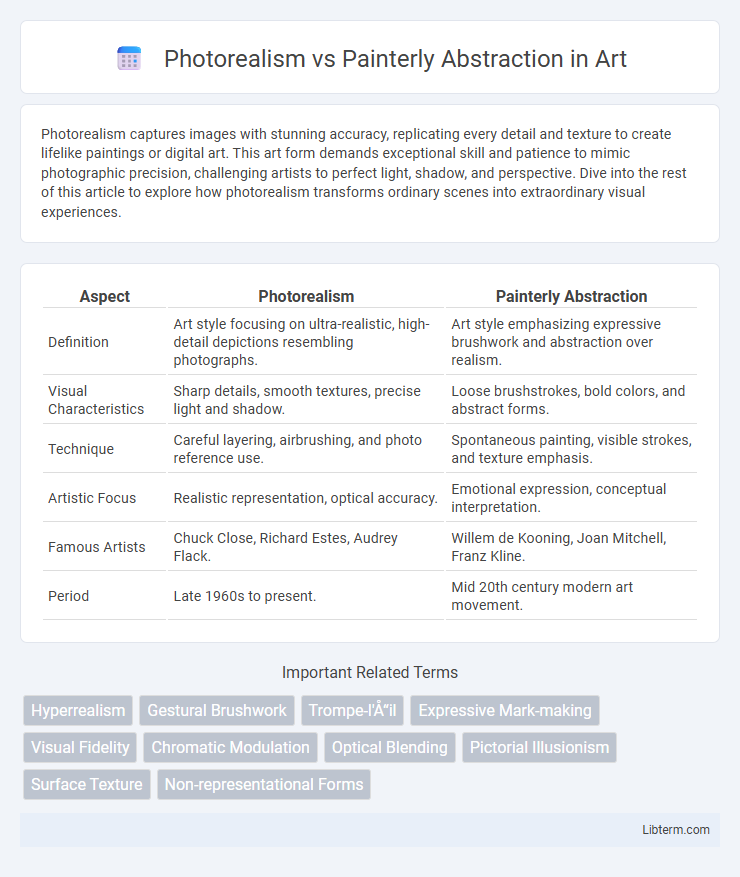Photorealism captures images with stunning accuracy, replicating every detail and texture to create lifelike paintings or digital art. This art form demands exceptional skill and patience to mimic photographic precision, challenging artists to perfect light, shadow, and perspective. Dive into the rest of this article to explore how photorealism transforms ordinary scenes into extraordinary visual experiences.
Table of Comparison
| Aspect | Photorealism | Painterly Abstraction |
|---|---|---|
| Definition | Art style focusing on ultra-realistic, high-detail depictions resembling photographs. | Art style emphasizing expressive brushwork and abstraction over realism. |
| Visual Characteristics | Sharp details, smooth textures, precise light and shadow. | Loose brushstrokes, bold colors, and abstract forms. |
| Technique | Careful layering, airbrushing, and photo reference use. | Spontaneous painting, visible strokes, and texture emphasis. |
| Artistic Focus | Realistic representation, optical accuracy. | Emotional expression, conceptual interpretation. |
| Famous Artists | Chuck Close, Richard Estes, Audrey Flack. | Willem de Kooning, Joan Mitchell, Franz Kline. |
| Period | Late 1960s to present. | Mid 20th century modern art movement. |
Introduction to Photorealism and Painterly Abstraction
Photorealism is an art movement characterized by meticulous attention to detail and precision to mimic high-resolution photography, often using techniques such as airbrushing and layering to create lifelike images. Painterly abstraction emphasizes expressive brushstrokes, texture, and color fields rather than precise representations, focusing on emotional and interpretive content over realism. Both styles offer distinct approaches to visual storytelling, with Photorealism highlighting technical skill and Painterly abstraction prioritizing artistic intuition and sensory experience.
Defining Photorealism: Key Characteristics
Photorealism is characterized by its meticulous attention to detail, aiming to replicate photographs with high precision and clarity. Artists emphasize realistic textures, lighting, and reflections, often using photographs as reference points to achieve lifelike accuracy. The movement highlights technical skill and visual exactness, distinguishing itself from abstract or interpretive styles by presenting subjects in an almost photographic manner.
Understanding Painterly Abstraction: Essential Elements
Painterly abstraction emphasizes expressive brushstrokes, textured surfaces, and a departure from precise detail to evoke emotion and individual interpretation. Key elements include dynamic color variation, visible mark-making, and an intentional emphasis on form and composition over realism. This approach fosters a subjective visual experience, contrasting the meticulous representation found in photorealism.
Historical Development of Photorealism
Photorealism emerged in the late 1960s as a reaction against the emotional intensity of Abstract Expressionism, emphasizing meticulous detail and photographic precision achieved through techniques like grid projection and airbrushing. Artists such as Chuck Close and Richard Estes pioneered this style by translating photographs into highly detailed paintings that capture reflective surfaces and urban scenes with striking realism. The movement reflected a broader cultural interest in media and technology, situating Photorealism as both a technical and conceptual continuation of American Realism.
Origins and Evolution of Painterly Abstraction
Painterly Abstraction emerged in the early 20th century as a response to the rigid precision of Photorealism, emphasizing expressive brushstrokes and emotional depth over exact replication. Rooted in movements like Abstract Expressionism and Post-Impressionism, this style evolved through artists such as Willem de Kooning and Franz Kline, who prioritized dynamic compositions and textured surfaces. Over decades, Painterly Abstraction expanded to challenge traditional realism by focusing on subjective interpretation and the materiality of paint itself.
Techniques and Tools: Photorealist Approaches
Photorealist artists employ precision tools such as airbrushes, fine-tipped brushes, and high-resolution photographs to achieve minute details and exact textures, capturing reflections and light effects with photographic clarity. Techniques include layering thin glazes, meticulous blending, and the use of grids or projection methods to accurately transfer images onto canvas, ensuring proportional accuracy. Digital tools like graphic tablets and software also support photorealists in refining intricate details and enhancing the replication of reality.
Methods and Styles in Painterly Abstraction
Painterly abstraction employs loose brushstrokes, textured surfaces, and vibrant color fields to emphasize emotion and spontaneity over precise representation. Techniques often include layering, dripping, and gestural marks, creating dynamic compositions that prioritize individual expression and materiality. This style contrasts sharply with photorealism's meticulous detail and smooth finish, focusing instead on the physicality of paint and interpretive visual language.
Emotional Impact: Realism vs. Abstraction
Photorealism captures minute details and lifelike impressions, evoking emotional responses through familiarity and precision that resonate with viewers on a personal level. Painterly abstraction emphasizes expressive brushwork and color dynamics, enabling a more subjective and interpretive emotional experience. The contrast between these styles highlights how visual accuracy versus imaginative freedom influences viewer engagement and emotional depth.
Major Artists: Icons of Both Movements
Chuck Close and Richard Estes are iconic figures in Photorealism, celebrated for their meticulous attention to detail and lifelike representation. In contrast, Willem de Kooning and Franz Kline dominate Painterly Abstraction, known for their expressive brushwork and dynamic compositions. These artists exemplify the distinct approaches and philosophies defining the two influential art movements.
Choosing a Style: Artistic Intent and Audience Reception
Choosing between Photorealism and Painterly Abstraction hinges on artistic intent, where Photorealism emphasizes meticulous detail and lifelike representation to evoke clarity and realism, while Painterly Abstraction prioritizes expressive brushwork and emotional resonance through distortion and abstraction. Audience reception varies as Photorealism appeals to viewers seeking technical skill and recognizable imagery, whereas Painterly Abstraction attracts those who appreciate interpretive and subjective experiences. Understanding the target audience's preferences and the desired emotional impact guides artists in selecting the appropriate style for effective communication.
Photorealism Infographic

 libterm.com
libterm.com